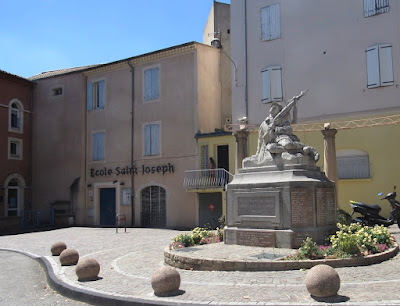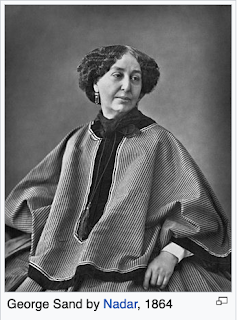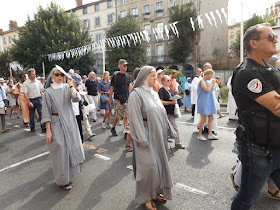
It's summertime in Le Puy and Eluiza and I took some vacation time from the Centre with several day trips around the Auvergne area. Here are some short clips of our activities that not only created some fabulous memories but provided us with some great summer fun.
Lavoûte-Chilhac
Eluiza was looking for a few wheat stalks to put in our chapel and flower vases around the Centre. Unfortunately, farmers had already cut most of the wheat so the few stalks that we wanted were hard to find.
We nevertheless continued our afternoon drive to Lavoûte-Chilhac, which was a priory town back in 1025. It runs along the Allier River, which provides some very picturesque scenes. This area is a recreation area during the summer, and kayaks were there out for hire. This picture was taken from a small café that overlooks the river where we had a delicious crêpe and coffee break. So although our mission in finding wheat stalks was dashed, the afternoon was pleasant and enjoyable. 
For more about Lavoûte-Chilhac and its abbey, see my 2020 blog post and scroll down halfway.
Saint-Etienne-du-Lugdarès -- Institute Sisters of St. Joseph
Behind Sister Marie and Eluiza is the sisters' former motherhouse, which they left in 2008 after being a presence in the community since 1833. They sold it to the city, and it was converted it to government offices and public services. The plaque on the front of the building reads: "In homage and gratefulness to the Congregation of the Sisters of St. Joseph for the numerous services given to the people."

 Across the street from the former motherhouse was the birthplace of a famous French writer and adventurer, Henri Charriere (1906-73). He was sentenced to prison in 1931 for murder and pardoned in 1970. He wrote the novel Papillon, a memoir of his incarceration and escape from a penal colony in French Guiana. Charrière denied committing the murder but freely admitted to various other petty crimes in his younger days.
Across the street from the former motherhouse was the birthplace of a famous French writer and adventurer, Henri Charriere (1906-73). He was sentenced to prison in 1931 for murder and pardoned in 1970. He wrote the novel Papillon, a memoir of his incarceration and escape from a penal colony in French Guiana. Charrière denied committing the murder but freely admitted to various other petty crimes in his younger days.
The main street of St. Étienne is a pilgrimage route as well as a favored roadway for motorcycles. The quiet rural area is frequently disturbed by loud, freedom-loving motorists, said Sister Marie.

The church in the town had some interesting things to see. The pulpit was an elaborate white marble structure with beautiful carvings of the Evangelists.


The church features a medieval crucifix.


Every French church posts the names of the fallen in World War I, II, Algeria, and Vietnam. This was the first time I'd seen photos of the men memorialized.
Notre Dame des Neiges
High in the Cervennes Mountains lies the remote Cistercian monastery of Notre Dame des Neiges. It was the home of the now-canonized Charles de Foucauld (1858-1916), a former Army officer in the Algeria who afterward entered the Order in 1890. His inspiration and writings led to the founding of the Little Brothers of Jesus among other religious congregations.

This statue represents Notre Dame des Neiges (Our Lady of the Snows). It is a contemporary statue inspired by the medieval Virgins typical of the Auvergne area and the icon of Notre-Dame des Neiges, a painting that hangs in Sainte-Marie Majeure Church in Rome.
For more on our first trip to Notre Dame des Neiges, click on to my blog post of 2018.
To illustrate the power of this place, I had an inspiration while seated on a park bench overlooking the monastery's pasture. The barbed wire had only two lines. When I first came to Le Puy in 2017, I had a dream that I was trying to cross a field that was blocked with thick and knotted barbed wire that had a hole in it that I could see through. This dream occurred at a time I was trying to learn French. The barbed wire represented the barrier to fluency. So seeing this barbed wire today gave me hope that I was making a breakthrough with my language skills.
La Chaise Dieu
We arrived in time for Mass in the main church and sat in the 14th century monks' stalls. Although we were not treated to the big organ's music, we happened upon an art fair on the town's main drag.
However, the highlight of our visit were the 15-16th century tapestries on the Life of Christ with connections from the Old and New Testaments. They were absolutely breath-taking in size, color, craftsmanship, and narrative. They come in 3 parts: one aspect in the life of Christ in the middle, its Old Testament connection on the left and its New Testament connection on the right.

 The tapestries used to hang above the monks' stalls (left). Today, they are in a separate room in the abbey that is climate controlled. The tapestries are part of a tour that takes visitors around different parts of the abbey. When we return here some other time, I would definitely want to see the tapestries again. They are too formidable to take in only once.
The tapestries used to hang above the monks' stalls (left). Today, they are in a separate room in the abbey that is climate controlled. The tapestries are part of a tour that takes visitors around different parts of the abbey. When we return here some other time, I would definitely want to see the tapestries again. They are too formidable to take in only once.


Cloister courtyard ambulatory with quatrefoil windows. A typical design of Benedictine abbeys. Trefoils and quatrefoils are regarded as openings for the Holy Spirit to enter a place.
For more about La Chaise Dieu abbey, see my blog of December 10, 2019.
We also stopped for a meal at our favorite restaurant, Au Four à Bois. It's an Italian restaurant that features delicious pasta, salads, and omelettes. Here's a sample of Eluiza's carbonara and my bolognese pasta and chicken cutlet along with our dessert and coffee.

Château de la Rochelambert
 We
have passed it several times on our way to other places, but this time
we made it our destination. The Château de la Rochelambert is built on the side of a hill and
overlooks a broad valley of forest near Saint-Paulien.
We
have passed it several times on our way to other places, but this time
we made it our destination. The Château de la Rochelambert is built on the side of a hill and
overlooks a broad valley of forest near Saint-Paulien.
The
château was built in 1074 and served as a fortification that
protected pilgrims en route to Compostelle, Spain. In 1562 the château was
attacked by the Protestants who destroyed parts of it. A few decades
later it was repaired by Hélène de Lestrange, spouse of François, the
marquis of La Rochelambert. The La Rochelambert
family owned the château until 1922 when they sold it to Monsieur Bresset,
an antique dealer. He furnished it with priceless items of art. The
château was also used in 1962 as the set for 13 episodes of a TV series
"The Beauty and her Phantom."
Amantine Lucile Aurore Dupin, better known as George Sand (1804-76), was a French novelist, memoirist, and journalist who stayed at the château in 1859. She was inspired to write a novel, Jean de la Roche (Jean of the Rock), that takes place at the château. She writes:
"The small manor is, as far as the exterior, a true gem of architecture....Everything built out of local tawny lava rock, it does not make it look too badly, seen from the other side of the ravine, it is like a work cut out of cork, especially because of the thickness of the rock, which makes it implausible."
Sand was one of the most famous writers of the European Romantic era and well-respected by the French literary and cultural elite. Her father was of noble birth and her mother a commoner. Like many other famous women of the time, she liked to dress in men's clothes in public and smoke tobacco. Her novels and political commentaries likewise carried a subversive tone. She had many affairs, including one with Frederick Chopin.
The château has many religious art pieces as well as military swords and armor. However, one of its most stunning art pieces was Jesus riding a donkey to Jerusalem. I have never seen a sculpture like it. Its size alone, more than 5 feet high, created a powerful and inspiring impression. On the right, the lord's bed features elaborate oak carvings with a canopy.
Privas

Today, we were on a research mission in Privas to try to find the place where the guillotine might have been for three of our sisters who were beheaded during the French Revolution. Three other sisters were guillotined in Le Puy in Place Martouret. Their crime? They hid priests who would not take the Oath of Loyalty to the Revolutionaries and abandon their commitment to the Church. Although we could not confirm where the guillotine was, we deduced that it was here because World War I memorials are usually put in an important place. It was interesting that we also found this school named after St. Joseph. Perhaps our sisters once taught there. We need to do further research on this, however.
The
trip to Privas was far from home, so we packed a lunch and ate it in a little square in a little town nearby. Afterward, we
celebrated the balmy summer day with a delicious cup of coffee in an outdoor café in Privas.

Saturday is "Free Day"
 In
these last days of summer before the busy second half of the season
begins, we savor every moment by doing the things we want to do. I went
shopping at the street market and afterward had some coffee and a cheese/egg galette at my favorite outdoor café, the Santa Lucia in Place
du Plot. Delicious!
In
these last days of summer before the busy second half of the season
begins, we savor every moment by doing the things we want to do. I went
shopping at the street market and afterward had some coffee and a cheese/egg galette at my favorite outdoor café, the Santa Lucia in Place
du Plot. Delicious!
Lac Bleu

It was a long walk upward and we didn't know where it would lead us. However, when we arrived, we found a stunning blue-colored lake. In 90-degree heat, a walk in the forest was refreshing, and we were rewarded with this small jewel of a lake. The rich, blue color was the result of run-off from the area's previous days of mining tungsten. The photos below show the path to the lake, the small fish in the lake, and the picturesque rocks in and around the lake.



Assumption Eve -- August 14
The mayor of Le Puy held a reception at the Hôtel de Ville in honor of our new bishop, Yves Baumgarten who was appointed by Pope Francis in February. The mayor took the annual occasion of the Assumption to recognize the Catholic faith and its contributions to the community.The bishop previously served as vicar general of the Diocese of Lyon. He succeeds Bishop Luc Crepy, who left last year to head the Versailles diocese.
 The event also gave us an opportunity to see the inside of the Hôtel de Ville. We stood at one of the windows and looked out at Place Martouret below. This view had great meaning for us since three of our sisters were guillotined in this square during the French Revolution. People watched the spectacle from these same windows.
The event also gave us an opportunity to see the inside of the Hôtel de Ville. We stood at one of the windows and looked out at Place Martouret below. This view had great meaning for us since three of our sisters were guillotined in this square during the French Revolution. People watched the spectacle from these same windows.
Assumption -- August 15

Assumption celebrates the ascension of the Blessed Mother to Heaven. This is a BIG feast day in the Catholic Church. France, in general, is very devoted to her as well. Since the Cathedral goes by this name: Notre Dame of the Assumption it is one of the biggest
celebrations in Le Puy with a procession and
prayers around the old city. The procession route is lined
with blue and white streamers. Speakers are placed along the route for the prayers and
songs. Thousands of people of all ages and stations in life show up as a witness to their faith.


Fortunately, after 6 weeks of a heat wave in the high 90s, the weather cooled down just in time for the procession. This video provides a sample of the procession's beginning on the city streets.
The summer came to a close with relief from a six-week-long heat wave in the 90s and sometimes over 100 degrees. We had become more familiar with the incredible landscapes and history of the Auvergne area in which Le Puy lies. And, we were ready to receive the many guests who are coming to the Centre during the second half of the 2022 season. Although the season had been modified a bit from our original plan of 6 programs, we have had a full and busy year, the first since the Covid pandemic closed us down for 2 years. It's been very good to get back to our mission!

























































